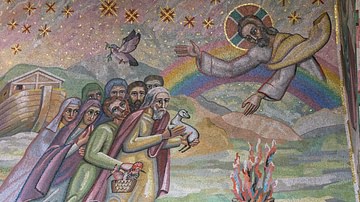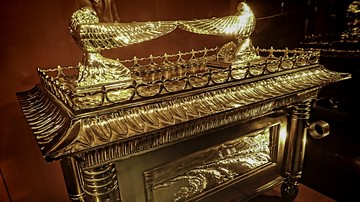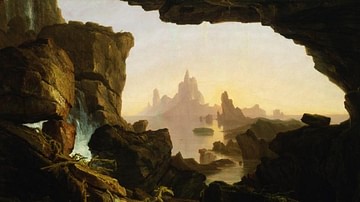
Noah’s Ark is the boat that saved a generation of humans and animals when the God of Israel decided to destroy the human race by sending a great flood upon the earth. The story shares many elements with ancient, neighboring civilizations of Israel, all of whom utilized concepts of a universal flood, sent by divine elements for various reasons.
Many ancient flood stories were the result of a god or gods sending a form of punishment for perceived disrespect or “the evil of humans.” The word “ark” derives from Old English for a “chest or a box.” The Hebrew word, teva, was also used for the small, papyrus boat that rescued Moses. In this sense, both served as “vessels of salvation” for the Jewish people.
In the book of Genesis, many of the patriarchs lived to be hundreds of years old (Noah died at 950 years). There is no explanation in the text for this phenomenon. But a change occurred beginning in Genesis 6-9:
When human beings began to increase in number on the earth and daughters were born to them, the sons of God [the angels of God’s court] saw that the daughters of humans were beautiful, and they married any of them they chose. Then the Lord said, “My Spirit will not contend with humans forever, for they are mortal; their days will be a hundred and twenty years. The Nephilim were on the earth in those days—and also afterward—when the sons of God went to the daughters of humans and had children by them. They were the heroes of old, men of renown ...
The “Nephilim” here may refer to those ancient "giants" which many cultures had in their folk-tales. In later Jewish tradition, the ”sons of God” in this story were blamed for also teaching humans the art of metallurgy, which led to the evils of weapons and money (in The Books of Enoch).
The Lord regretted that he had made human beings on the earth, and his heart was deeply troubled. So the Lord said, “I will wipe from the face of the earth the human race I have created—and with them the animals, the birds and the creatures that move along the ground—for I regret that I have made them. But Noah found favor in the eyes of the Lord.
Noah was a righteous man, blameless among the people of his time, and he walked faithfully with God. Noah had three sons: Shem, Ham, and Japheth.
Noah's Instructions
Noah was given very specific directions on the building of the Ark:
So make yourself an Ark of cypress wood; make rooms in it and coat it with pitch inside and out. This is how you are to build it: The Ark is to be three hundred cubits long, fifty cubits wide and thirty cubits high. Make a roof for it, leaving below the roof an opening one cubit high all around.
Although speculation only, if we take this to be what was known as the “royal cubit" (applied in ancient Egypt), from the tip of the middle finger to the elbow, the Ark would be approximately 500 feet long (over 150 metres).
Put a door in the side of the Ark and make lower, middle, and upper decks. I am going to bring floodwaters on the earth to destroy all life under the heavens, every creature that has the breath of life in it. Everything on earth will perish. But I will establish my covenant with you, and you will enter the Ark—you and your sons and your wife and your sons’ wives with you. You are to bring into the Ark two of all living creatures, male and female, to keep them alive with you. Two of every kind of bird, of every kind of animal and of every kind of creature that moves along the ground will come to you to be kept alive. You are to take every kind of food that is to be eaten and store it away as food for you and for them.’ Noah did everything just as God commanded him.
Genesis was composed of both oral traditions and “updated” material over many centuries. The scholarly consensus is that the first five books of the Scriptures were first written down c. 600 BCE, with the final editing completed during the period of “the Exile” in Babylon/Persia in the fifth century BCE. Like many other stories in Genesis, there is often two and sometimes three versions of the same story.
This passage is followed by what may have been a later “priestly” contribution, by repeating the instructions, but adding:
You shall take with you of every clean animal by sevens, a male and his female; and of the animals that are not clean two, a male and his female; also of the birds of the sky, by sevens, male and female, to keep offspring alive on the face of all the earth.
(Gen. 7:1-3).
This was most likely inserted after the composition of what became the Book of Leviticus, which listed the dietary laws for Jews, with “clean” and “unclean” examples of permitted foods (Leviticus 11).
Surviving the Great Flood
When God sent the flood waters, it “rained for forty days and forty nights,” and the subsequent water on the earth remained for “150 days.” As the waters receded, the Ark settled on top of Mt. Ararat (identified today on the border between Turkey and Russia). Noah sent out first a raven, and then a dove (Genesis 8:8-12). After seven days, the dove returned with an olive leaf, which indicated that there were now portions of land that had dried. Noah and his family and the animals emerged so that they could “multiply on the earth and be fruitful and increase in number on it.”
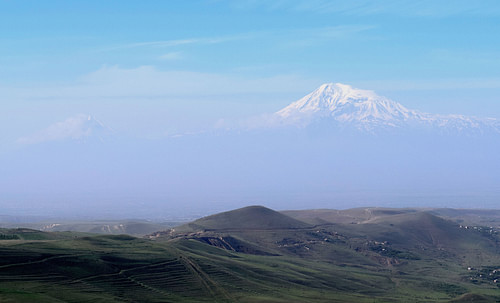
Noah then built an altar to the Lord and, taking some of all the clean animals and clean birds, he sacrificed burnt offerings on it. The Lord smelled the pleasing aroma and said in his heart: ‘Never again will I curse the ground because of humans, even though every inclination of the human heart is evil from childhood. And never again will I destroy all living creatures, as I have done.’
This promise became known as “the Covenant with Noah.” Covenants were understood as “contracts” between the divine and humans. “And God said, ‘This is the sign of the covenant for all generations to come: I have set my rainbow in the clouds, and it will be the sign of the covenant between me and the earth.’”
The later books of the Prophets claimed that the God of Israel would intervene in human history one more time (“in the final days”) to institute his “kingdom on earth” (the original concept of Eden). Holding to this covenant it was understood that the “tribulations” that would precede the intervention would not include another universal flood, nor the total destruction of everything. Even with the flood, the earth itself had not been destroyed.
And God blessed Noah and his sons, and said to them, 'Be fruitful, and multiply, and replenish the earth. And the fear of you and the dread of you shall be upon every beast of the earth, and upon every fowl of the air, upon all that moves upon the earth, and upon all the fishes of the sea; into your hand are they delivered.'
This reiterated the creation story of Genesis 2 when God created Adam and put him in charge of all the animals, birds, and plants in Eden.
Every moving thing that lives shall be meat for you; even as the green herb have I given you all things. But flesh with the life, which is the blood, you shall not eat. And surely your blood of your lives will I require; at the hand of every beast will I require it, and at the hand of man; at the hand of every man's brother will I require the life of man. Whoever sheds man's blood, by man shall his blood be shed: for God made man in his image.’
This became the explanation for the institution of animal sacrifices in ancient Judaism and the Jewish practice of draining the blood from butchered animals before eating. It also led to the Mosaic laws that defined murder and its subsequent punishments.
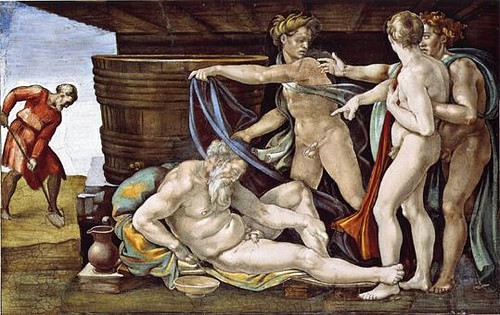
The Descendants of Noah
Genesis 10:1–32: “These are the generations of the sons of Noah, Shem, Ham, and Japheth.” Having wiped out all other humans, the world needed to re-populate so that the sons of Noah became the ancestors of different genealogies. But an odd story concerning Ham continues to be debated. We read that Noah “planted a vineyard.” All ancient pantheons portrayed one of the original gods or goddesses with the introduction and arts of agriculture. For example, Ceres as the originator of grain and Dionysus as the originator of vine-growing.
Noah then became drunk on the wine, passed out, and lay “uncovered" in his tent.
And Ham, the father of Canaan, saw the nakedness of his father, and told his two brothers outside. And Shem and Japheth took a garment and laid it upon both of their shoulders, and went backward, and covered the nakedness of their father. . . And Noah awoke from his wine and knew what his youngest son had done to him. And he said, ‘Cursed be Canaan; a servant of servants shall he be to his brothers.’
The problem is found in the cursing of Canaan, instead of Ham. And the actual sin of Ham has been debated for centuries.
The later Rabbinic Targum Ongelos, from the line, “and told his two brothers outside,” was interpreted that Ham had mocked his father, and “taking it outside” was the equivalent of mocking him “in the streets.” Some interpreters attempted to connect it to the incest legislation of Leviticus 20; “seeing one’s nakedness” could be understood as “the uncovering of nakedness” of near relatives, a euphemism for sexual intercourse, suggesting that Ham was guilty of some sexual sin such as sodomy.
A fuller understanding of the story is perhaps found in the descendants of Ham, through his son, Canaan, who produced the Mizraim (Egypt), the anthropological category of what became known as “Nilo-Hamitic” for sub-Saharan Africa, and the Canaanites. The later story of the Exodus from Egypt depicted the God of Israel outdoing the gods of Egypt through the stories of the Ten Plagues. In the stories of the attempts to settle in Canaan, “as descendants of Ham,” the slaughter of the Canaanites in the book of Joshua was rationalized as enemies of God, “under the curse.” A 19th-century mistranslation, that “Ham,” meant “dark,” became the rationale for the institution of slavery by European colonizers and the American Southern states.
Comparable Myths
Ancient civilizations in the regions had similar stories associated with devastating floods. The “fertile crescent,” the area between the Tigris and Euphrates rivers, periodically flooded, helped later with the construction of irrigation canals. The Nile river in Egypt flooded every summer, sometimes providing an adequate level to nurture the farms, while at other times, overflooding and destroying farmed areas. Scientists have also attempted to measure ancient flooding along the coastal regions of the Black Sea to determine the frequency of flooding. Other world cultures share ancient, universal flood traditions, such as China. Many of the flood stories involve similar concepts of either punishments or “starting over.”

During the Victorian age, with the new science of archaeology, Europeans began excavations throughout the Middle East. Uncovering vast libraries of cuneiform tablets, they discovered an early version of this story in the Sumerian/Mesopotamian/Babylonian Epic of Gilgamesh (c. 1300-1000 BCE). Gilgamesh was a legendary king of the Sumerian city of Uruk. Gilgamesh sought the secret of immortality. Through his travels, he narrated the story of a great flood. One of the gods, Enlil, sent the flood to punish humans for their “great noise” (or, their evilness). The Epic of Gilgamesh is notable for its similar details of not only a flood story, but with the “cubits,” the use of “pitch” (tar) to seal the structure, and even sending out the birds.
“Great flood stories” were found in Hesiod’s The Theogony (8th century BCE), Plato’s Timeaus (5th century BCE), Aristotle’s Meterology (4th century BCE) and Pseudo-Apollodorus’ The Library (50 BCE). The Greek/Roman version of a flood story was related in Ovid’s The Metamorphoses (c. 8 CE). After appearing in human form to visit the house of Lycaon, Zeus/Jupiter became angry because of the lack of piety on the part of Lycaon, who served him a meal with human flesh, and so he wanted to punish all humans. The son of the Titan Prometheus, Deucalion (“son of forethought”) and his wife Pyrrha (“daughter of afterthought”) were warned of a coming flood and they built a boat to survive. They later embarked and visited the temple of Themis to ask for help in populating the human race. They were to “leave the temple with veiled heads . . . and throw behind you the bones of your great mother.” The couple then realized that the “bones” were the stones of “mother earth.” They threw them and watched as the bones softened and turned into humans. Animals were spontaneously created from the earth. Similar to the Biblical genealogies, Deucalion and Pyrrha produced two sons, who became the ancestors of the Aeolians, the Dorians, and the Achaeans.
Biblical Scholarship
The modern analysis of Biblical books began in the 18th and 19th centuries by recognizing the many and varied “sources” behind the Biblical texts and their editing over centuries. At the same time, many Bible stories (especially miracles), were treated with skepticism concerning their improbable events. The details of the Ark were often considered impossible, with the problems of building such a large vessel, collecting “all of the animals of the earth,” including the carnivores, feeding, and cleaning up after them. Theologically, there were problems with a God who “regretted his creation.” If the God of Israel was omniscient (all-knowing), did he not know that humans were going to commit evil?
The Search for Noah’s Ark
Apparently, the “search for Noah’s Ark” has been on-going since antiquity. The Jewish historian, Flavius Josephus wrote:
Now all the writers of barbarian histories make mention of this flood, and of this ark; among whom is Berosus the Chaldean. For when he is describing the circumstances of the flood, he goes on thus: ‘It is said there is still some part of this ship in Armenia, at the mountain of the Cordyaeans; and that some people carry off pieces of the bitumen, which they take away, and use chiefly as amulets for the averting of mischiefs’
(The Antiquities of the Jews, Book I).
The Christian historian Eusebius (ca. 275-339 CE) reported that people were searching for Noah’s Ark.
Modern activity is focused on the slopes of Mt. Ararat in Turkey. Others locate it in the mountains of Armenia. The first attempt to climb Mt. Ararat was by Friedrich Parrot in 1829, followed by James Bryce in 1876. He claimed to have found a piece of wood four feet long and five inches thick, cut by a tool. As an April Fool’s joke in New Zealand, George Reed published a story in 1883 that an avalanche on the mountain had uncovered the Ark and was published by several other newspapers, stimulating renewed interest in the relic.
In 1940, an article ran in an edition of New Eden, a booklet published by Floyd M. Gurley of Los Angeles. “Noah’s Ark Found,” claimed that a Russian aviator in WWI, Vladimir Roskovitsky, flew over Mt. Arafat and saw an enormous shipwreck on the shore of a lake. Allegedly, a report was sent to Tsar Nicholas, but the report was destroyed when he was executed by the “anti-religious” Bolsheviks.
The next few decades saw expeditions that involved the finding and interrogating of local “guides” who lived in the area, all of whom allegedly told stories of seeing the Ark from their fathers and grandfathers.
Various organizations have claimed to have photographs of Mt. Arafat through satellites and commercial drones, from an area that is known as the “Ararat anomaly.” However, as Mt. Ararat is on the border with Russia, the Turkish government is currently averse to granting permission for outsiders to excavate in the region, claiming security concerns.
Interest in finding Noah’s Ark remains important in Evangelical communities, concerned with proving this story as well as others in Genesis. Evangelical organizations have sponsored several life-size replications of the Ark as theme parks (complete with a zoo), such as the one in Williamstown, Kentucky.




